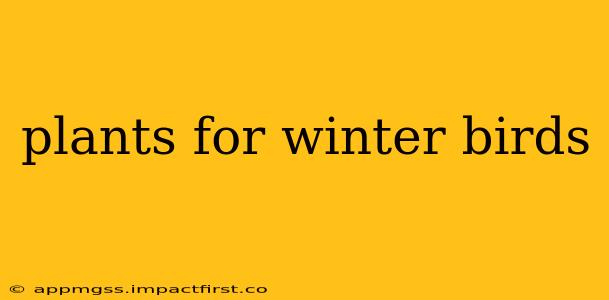Winter can be a tough time for birds. Food sources dwindle, and harsh weather conditions make finding sustenance even more challenging. Providing supplementary food is a common practice, but creating a bird-friendly garden with plants that offer sustenance throughout the winter months is an even more rewarding approach. This not only helps birds survive but also enriches your garden with beauty and biodiversity. Let's explore the best plants to attract and feed winter birds.
What Plants Produce Berries in Winter?
Many birds rely heavily on berries during winter. These provide vital energy reserves to help them cope with the cold and limited food availability. The key is to choose berry-producing plants that retain their fruit well into the winter months, ideally after the first frosts.
Top Choices:
-
Holly (Ilex): Various holly species offer vibrant red berries that persist throughout winter, attracting a wide range of birds including robins, waxwings, and thrushes. Consider Ilex aquifolium (English Holly) or Ilex verticillata (Winterberry Holly) for their winter hardiness.
-
Pyracantha (Firethorn): These shrubs boast masses of bright red, orange, or yellow berries that are a feast for birds. They're relatively low-maintenance and provide excellent winter interest.
-
Cotoneaster: Various Cotoneaster species offer an abundance of small, dark berries that are highly attractive to birds. They are adaptable plants that thrive in various soil types.
-
Viburnum: Many viburnum species produce attractive berries that persist into winter, providing food for a variety of birds. Look for varieties like Viburnum opulus (Cranberry Bush Viburnum) or Viburnum tinus (Laurustinus).
-
Juniper: While not strictly a berry, the juniper's fleshy cones serve a similar purpose. These offer a good food source for birds, particularly finches.
What Other Plants Provide Winter Food for Birds?
While berries are a significant food source, other plants offer valuable sustenance during winter. These provide seeds, nuts, or even buds that birds can utilize.
-
Sunflower: Planting sunflowers provides abundant seeds that many birds relish. Choose varieties that are known for their large seed heads, allowing them to persist into the winter. Leave the seed heads on the stalks after flowering, as birds will readily feed on them throughout winter.
-
Conifers: Conifers like pines, spruces, and firs offer seeds that various birds, such as crossbills, can extract. The dense foliage also provides shelter from harsh weather.
-
Crabapple Trees (Malus): While the fruit may drop early, some varieties persist long enough to provide valuable winter food. The remaining fruit can also ferment, making for an enticing treat.
What Seeds Do Birds Eat in Winter?
Many bird species rely on seeds as a crucial food source during winter. While providing supplemental seed in feeders is helpful, having plants that provide natural seed sources is even better.
-
Weed Seeds: Don't be too quick to remove all weeds from your garden. Many weeds produce seeds that birds enjoy. Allowing some to go to seed can provide valuable winter food.
-
Grasses: Leaving some seed heads on ornamental grasses will also provide food for birds.
How to Attract Birds to Your Winter Garden?
To maximize the impact of your winter bird-friendly garden, consider these tips:
-
Plant a variety of species: This ensures a diverse food source throughout the winter months.
-
Provide shelter: Birds need protection from the elements. Evergreen shrubs and trees provide excellent shelter.
-
Avoid pesticides: Pesticides can harm birds directly or indirectly by reducing the availability of insects and other food sources.
-
Provide a water source: A birdbath, even if it needs to be kept ice-free, is essential, especially in freezing conditions.
By implementing these strategies and choosing the right plants, you can create a vibrant and thriving winter garden that not only delights you but also provides crucial sustenance for your feathered friends. Remember, a well-planned winter garden offers a significant contribution to the wellbeing of local bird populations.
